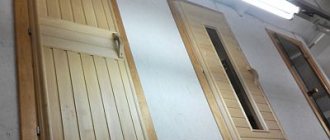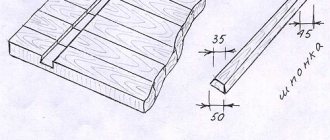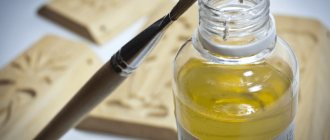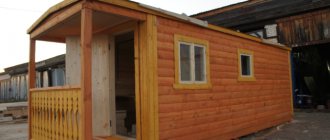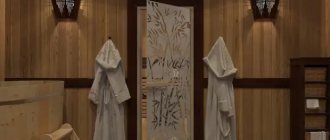Repair and decoration
06/12/2018 Anastasia Prozheva
A closer is a mechanical device designed to smoothly automatically close a door. Its use protects the entrance structure from premature wear and maintains the microclimate in the building. Entrance and interior doors are equipped with closers, in public buildings, between extensions, etc. How to adjust the door closer for comfortable operation of the mechanism?
Drawing of an entrance door closer.
The closer mechanism is adjusted both during installation of the device and during its operation. The closing speed of a soft-close door may decrease as the outside temperature decreases. This is due to the increase in viscosity of the oil used in the device. Therefore, additional adjustment of the input equipment is made with the onset of the winter period. Different device models have their own temperature range for normal operation.
The frequency of adjustment of the closer also depends on the duration of the previous operation of the device, the massiveness of the canvas, and the frequency of movement through the entrance. The closing mechanism should be adjusted at least 2-3 times a year.
Classification of closers
To figure out how to properly install a door closer with your own hands, you need to understand the design of the product. The modern market offers different models of finishing devices, which differ in design and performance characteristics.
Types of door closers according to installation method
- Hidden;
- Upper;
- Floor-standing.
Closing force
- Class EN1-EN7;
- Class EN5-EN 7.
Thanks to the variety of classes, you can choose a product with the most optimal closing force of the leaf for any door design.
Traction device
Lever rod is the simplest door closer in design, but not compact enough.
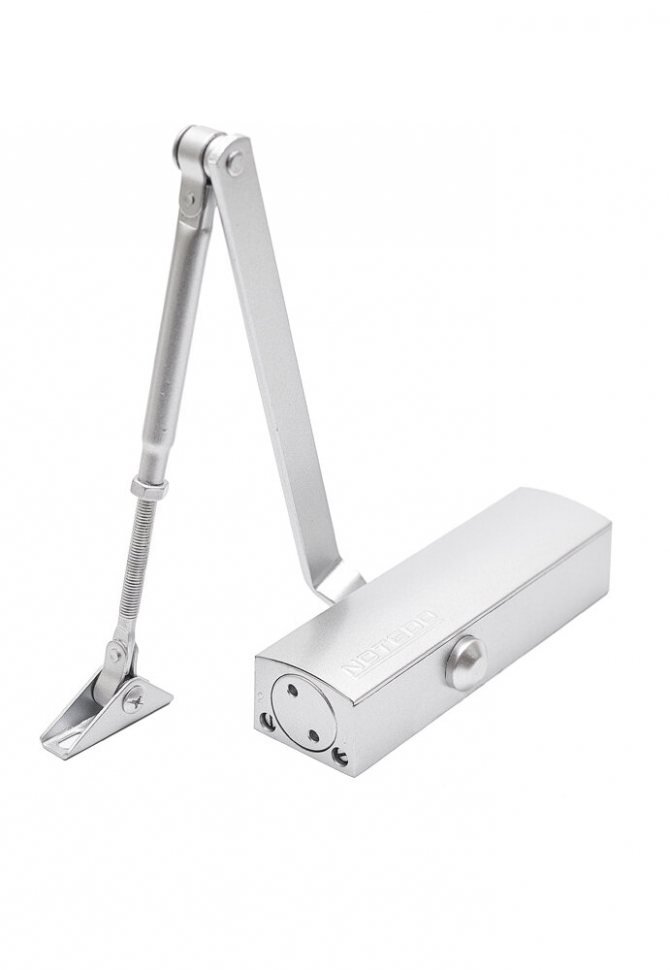
Rod with a sliding channel - the product is equipped with a cam mechanism, compact in assembly.
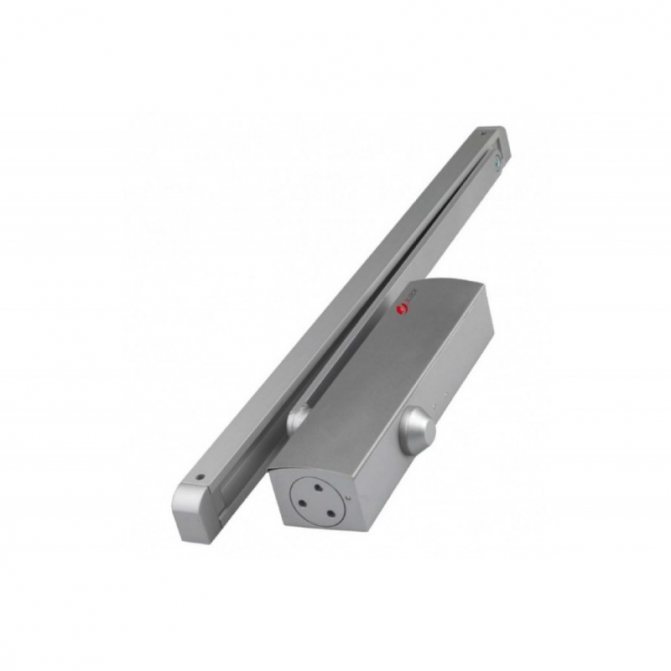
Floor traction – the finishing device is attached directly to the floor base.
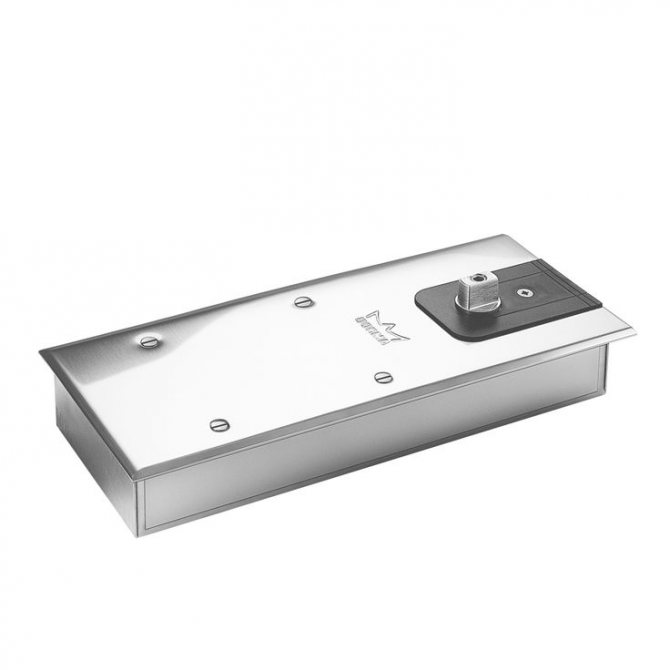
Working mechanism design
The spring design is already an outdated option.
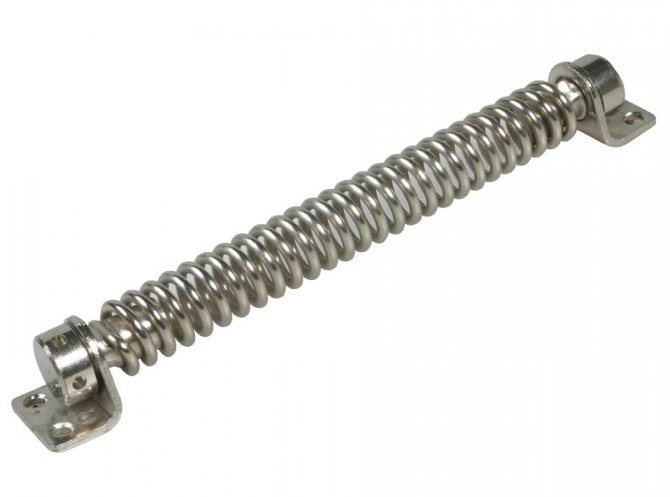
With a gear and rack - the most common mechanism, which provides a reinforced but smooth mode when closing the door leaf.
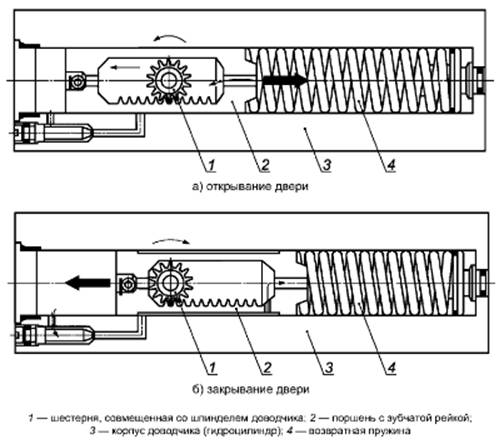
Cam is a universal option.
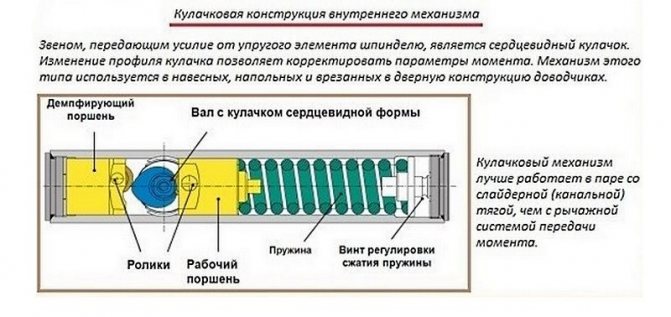
By installation type
- Hidden;
- Overlay or surface.
Additional options
- Door opening damper – used for external panels;
- Fixing the door in the open position – this function is used for entrance doors with heavy traffic;
- Closing delay – used for door structures in warehouses and utility rooms with low traffic;
- Coordination of closing door leaves – designed for fire doors and door blocks with two leaves;
Individual adjustment of the door slam – used for doors with rubber seals.
Design and principle of operation
The principle of operation is very simple: the device stores energy when the door is opened, overcoming the resistance of the spring, and returns it during closing.
The spring that pushes the lever is the main part of the mechanism. Based on the path of force transmission, the following types are distinguished:
- With lever pull. A system of levers perpendicular to the canvas is visible above the body of these models. The advantages of the design are its simplicity, fault tolerance and accessibility. There is also a drawback: the wider the sash opens, the harder you have to pull. This creates inconvenience for users in poor physical condition.
- With sliding channel. A lever parallel to the sash is used; this design looks better and there is no risk of breakage. In addition, after reaching an opening angle of 30°, the force on the handle decreases noticeably. This mechanism is convenient for children and the elderly.
An oblong body covering the mechanism is usually attached to the top of the blade. The other end of the lever pair is mounted on the frame. Any device can be mounted on both the right and left sides of the door.
For glass doors, the third layout option is used. The body with the mechanical part is recessed into the floor - only the mounting plate is visible. This solution is unnoticeable, but sensitive to dirt and damage.
Choosing a closer
Before you go to buy a door closer, you need to measure the weight and width of the door leaf. These are two main indicators that influence the choice of a product, or rather its technical characteristics.
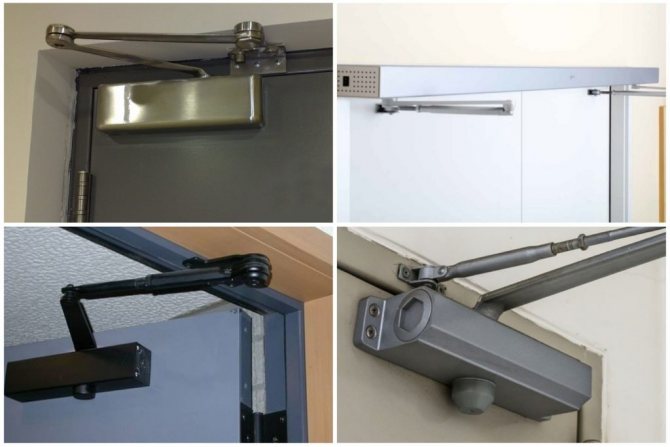
When selecting a model of the finishing mechanism, it is also necessary to take into account the temperature conditions in which it will be used and the features of the installation location of the device.
Installation instructions for the finishing mechanism
When installing the finishing mechanism on interior doors yourself, rack structures equipped with a lever mechanism are usually used. Devices equipped with a slider rod are rarely used for such purposes.
Hidden closers are used for glass door blocks. Rarely for other door designs. They are also used if necessary to maintain strictly the interior of the room.
The installation technique for all types of finishing structures is practically no different.
Definition of installation diagram
First of all, the procedure for installing a door closer on your own is determined. The installation technique will differ depending on the direction of opening of the door leaf:
- The canvas opens to the finishing device. In such a situation, the body is mounted on the canvas, the lever mechanism on the box;
- The sash opens from the closer. The body is mounted on the door jamb, a sliding channel is fixed to the door leaf;
- It is also necessary to take into account that the adjusting bolts are placed in the direction of the door hinges.
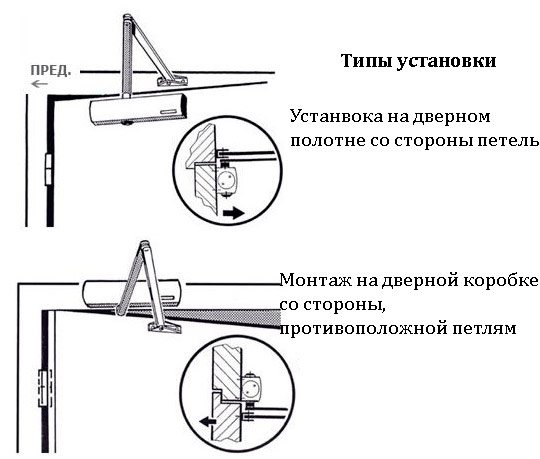
Using a template
The product delivery package necessarily includes an installation diagram made in actual dimensions. The areas for fixing the product body and the lever mechanism are clearly marked on it. This makes it much easier to install the mechanism yourself.

At the same time, the template provides all possible options for attaching the door closer: for external and internal door opening, for right-handed and left-handed leaves. The template also suggests a class of door blocks for which the product can be used.
Performing installation
Before installing a closer on the door yourself without a specialist, a product template, which is included in the product package, is attached to the plane of the door leaf. It must be applied to the fastening area exactly according to the diagram and secured with transparent tape. After this, the points for drilling holes for fasteners are marked on the canvas using a center punch.
The procedure for installing the mechanism:
The housing is installed and secured with mounting bolts. Correct installation is determined by the position of the adjustment screws.
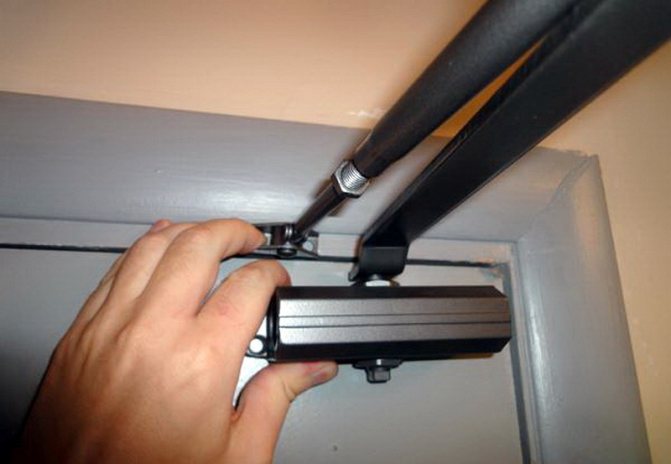
A lever structure is mounted on the opposite side of the door. Sometimes it is included in the package already assembled. The hinge is temporarily removed until the closer operation is adjusted.
Next, the knee is mounted - the non-adjustable part of the lever mechanism. To install the part, the axis of the finishing device is used. Fastening is carried out using a special wrench and nut.
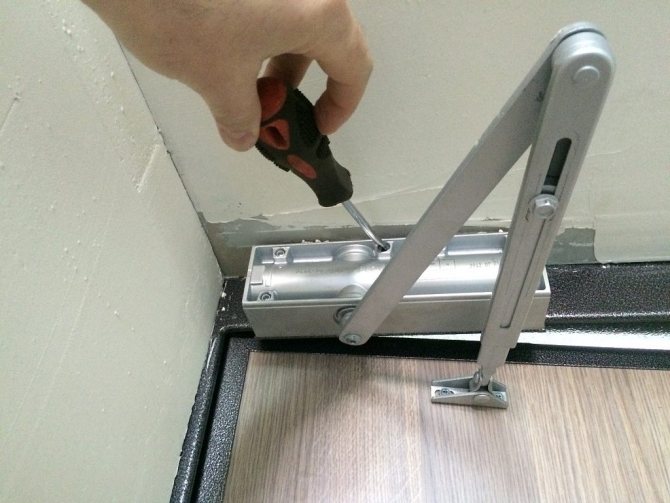
If the door is expected to close silently and smoothly, the knee is fixed perpendicular to the door leaf, and the lever is fixed at an angle. The connection of the elements of the finishing device is carried out only with the door tightly closed. If the purpose of installing a closer is finishing force, then the rigid lever is fixed perpendicular to the door leaf. This installation scheme is used for doors with latches and seals.
At the next stage of installation, it is necessary to adjust the length of the adjustable elbow to the rigid mechanism. This technology makes it possible to strengthen the spring of the device and speed up the closing of the door when closing.
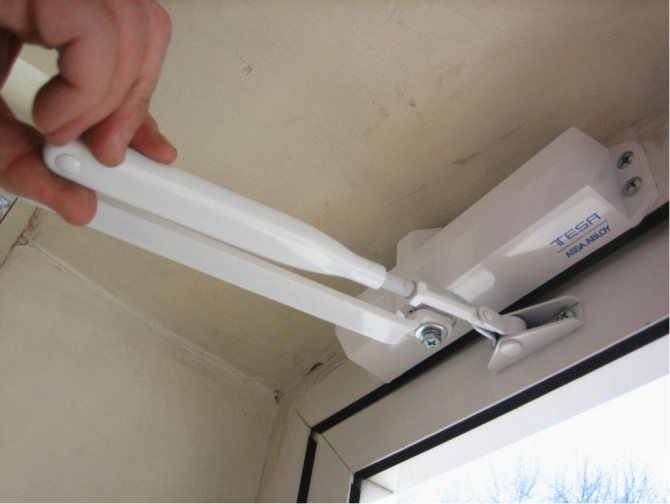
The final stage of self-installation of the finishing mechanism is the connection of the individual elements of the knee with a hinge.
If the model of the closing device is suitable for installation on door blocks made of any material (steel, wood, plastic), then the delivery set must include fasteners for all types of doors.
How to properly install a door closer on your own is shown in detail in the following video:
Features of non-standard installation
In some cases, it is necessary to use a non-standard technique for installing the finishing device on door blocks, for example, with a heavy metal leaf. For this, corners and plates are additionally used. Such fastening elements are already included in the package of individual products. But, often they have to be purchased separately.
In case of a deep entrance opening, which does not allow installation of a lever bracket on the frame, a construction angle is additionally used. Sometimes it is used to mount the housing and working system.
Installation of the housing is not always possible due to the design features of the door block. For example, the door block is equipped with a high glass insert. In such situations, the device body is mounted on a special plate. They are also used for leveling and fixing the body of the supply system when there is not enough space above the sash to fix the lever mechanism.
The size of the plate is selected accordingly to the size of the finishing device and the type of door leaf construction. Therefore, when purchasing a product, it is recommended to additionally consult with the seller in the store.
Instructions. How to make a door closer with your own hands from various materials
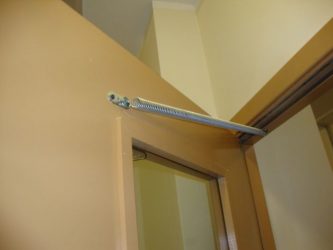
A door closer is a very useful thing in everyday life. After installing it, using the doors in your house or apartment will become much more pleasant. In a hurry, did you not have time to close the door? The closer will do this for you - quietly, carefully, without annoying clap.
The door closer is quite easy to make and install with your own hands, you just need to be smart.
A simple door closer option
To make your own door closer, you don’t need a lot of materials. First of all, before making a closer, you need to pay attention to its weight. To make the simplest design, you will need a weight.
Setting up the closer after installation
After the housing and lever mechanism of the closer has been installed on the entrance or interior door, you can adjust the equipment yourself.
When installing it yourself, it is not always possible to achieve correct operation of the finishing device the first time. And this can lead to rapid failure of the mechanism. Therefore, adjustments and adjustments after installation, during operation, especially during the changing seasons, are mandatory.
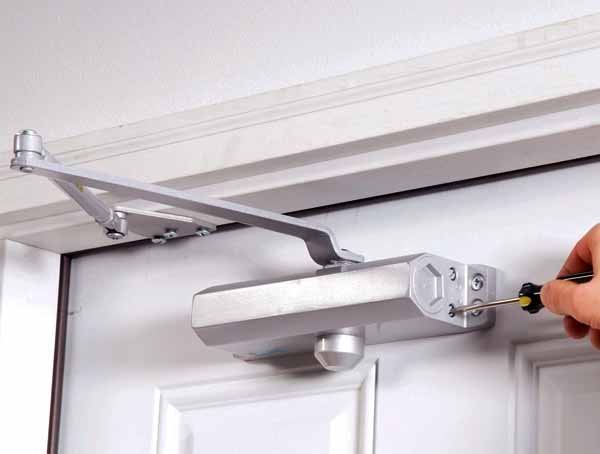
When setting up the operation of the device, it is first recommended to look at the speed of the closing sash. When the door moves slowly, the spring is adjusted. The nut, which is marked in the instructions with the corresponding symbol, is responsible for the compression force of the spring mechanism.
Almost all door closer models have 2 adjusting screws. One is responsible for the speed, the second for the density of the closure of the canvas. Some products are additionally equipped with a third valve, which is responsible for adjusting the movement of the door leaf at angles of 80º, 90º.
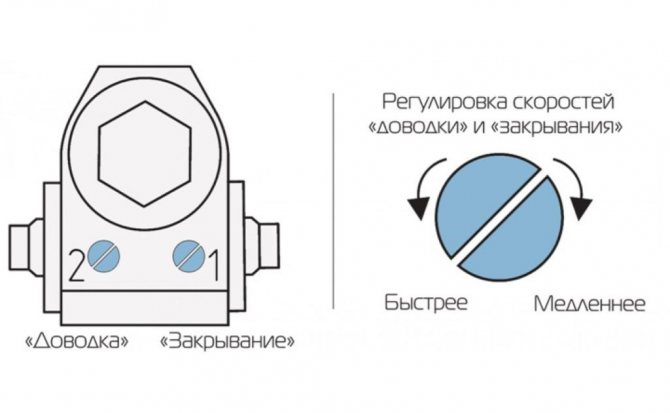
Also, during operation, it is necessary to lubricate the elements of the finishing mechanism; in some models, change the oil, which, as a result of temperature changes, loses its original properties. It is recommended to replace it at least 2 times a year, usually in winter and summer.
